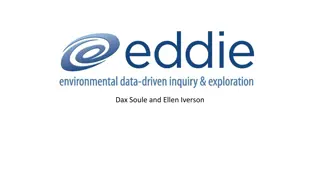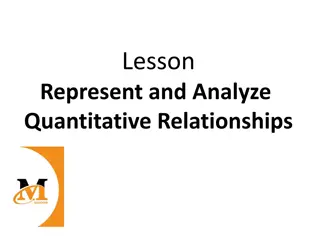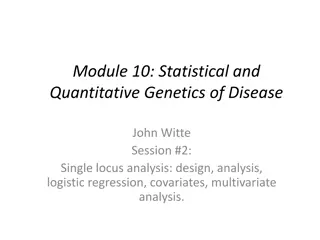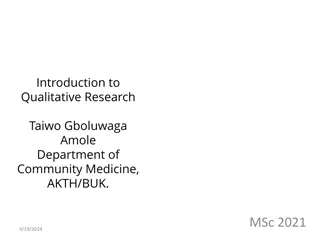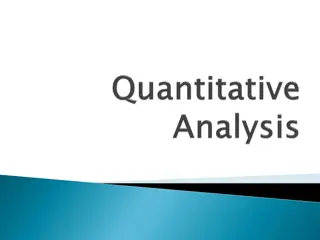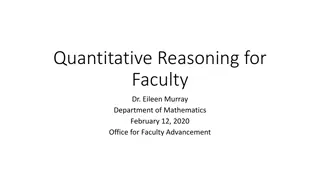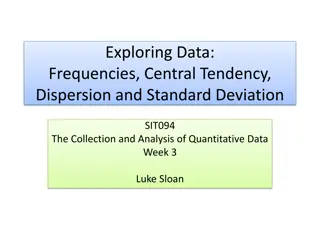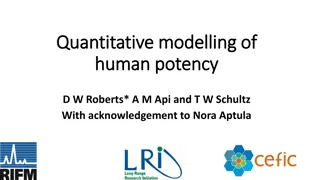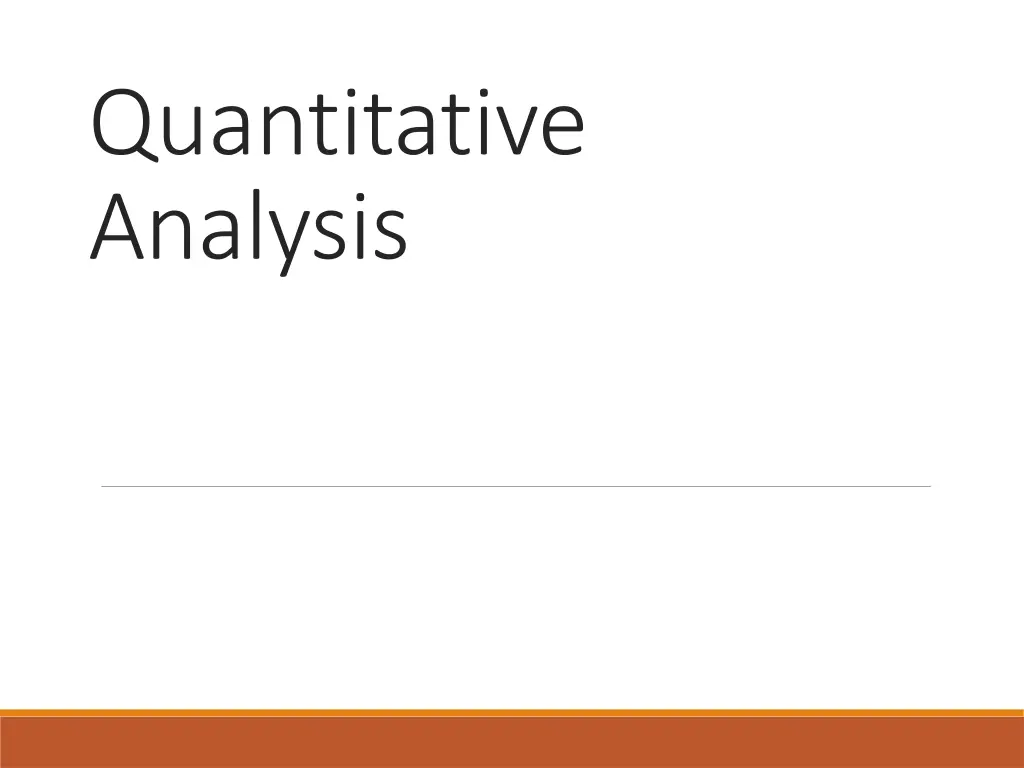
Qualitative vs Quantitative Analysis in Software Engineering
Explore the differences between qualitative and quantitative analysis in software engineering, their importance in decision-making, and the role they play in evaluating design decisions and tradeoffs. Learn how to approach tactics and quantitative analysis, and understand the guidance for characterizing quality attributes. Dive into queuing network analysis for evaluating computer system performance.
Download Presentation

Please find below an Image/Link to download the presentation.
The content on the website is provided AS IS for your information and personal use only. It may not be sold, licensed, or shared on other websites without obtaining consent from the author. If you encounter any issues during the download, it is possible that the publisher has removed the file from their server.
You are allowed to download the files provided on this website for personal or commercial use, subject to the condition that they are used lawfully. All files are the property of their respective owners.
The content on the website is provided AS IS for your information and personal use only. It may not be sold, licensed, or shared on other websites without obtaining consent from the author.
E N D
Presentation Transcript
Quantitative Analysis
Qualitative vs Quantitative Qualitative: relating to, measuring, or measured by the quality of something rather than its quantity. Tastes Great? Less Filling? myCourses has a user friendly interface? disagree strongly agree agree strongly disagree neutral Quantitative: relating to, measuring, or measured by the quantity of something rather than its quality. Miller Lite beer is ___ on the International Bitterness Units scale. myCourses responds on average ___ milliseconds per user request. R I T Software Engineering
Tactics and Quantitative Analysis Selecting architectural patterns and tactics requires a lot of qualitative decision making. Qualitative is necessary, but insufficient! Need to evaluate design decisions and cross QA tradeoffs Qualitative analysis checklists, thought experiments Informal discussion requirements covered, what can go wrong? Evaluation can benefit from quantitative analysis A more rigorous reasoning framework Data, data, data!! R I T Software Engineering
Quantitative Analysis Guidance Need a measurable quantitative characterization of the quality attribute of concern Derived from QA scenarios: Stimulus, environment, response, response measure Data sources - observations, experiments, modeling, or back-of-the- envelope estimates Examples: Availability compute steady state availability mean time to failure mean time to failure + mean time to repair = Performance throughput, latency, utilization R I T Software Engineering
Queuing Network Analysis Model the computer system as a network of queues associated with service centers Servers Networks Process components Evaluate performance based on relatively simple equations derived from queuing theory 10-30% accuracy R I T Software Engineering
Queuing Network Analysis Departing completed request. . . Arriving request Queue Service center i Queue Service center j Estimate or measure the request arrival rate ( ) and the service rate (service time per request, ) Solving simple equations yields performance measures: Service center utilization (% busy) Residence time average time spent at the service center (queuing + service); ~perceived response time Queue length Throughput rate requests pass through the service center Run what if experiments by varying and Tool: http://jmt.sourceforge.net/ Quantitative System Performance, Lazowska, et al R I T Software Engineering
Queuing Network Example R I T Software Engineering
Queuing Network Analysis Sample Equations R I T Software Engineering
Simple Example Queue Completed Request Server Request Starbucks customers arrive at a rate of 20 per hour and take 2 minutes to serve. = Service Rate = 60/2 = 30 customers per hour What happens if the number of customers exceeds the service rate? = Average Arrival Rate either measured or estimated When modeling queues, measurements are gathered and used to find a distribution that models the arrival rate. R I T Software Engineering
Another Analysis Example: Concurrent Pipelines Problem - real-time latency requirements for generated outputs The selected pattern - multiple processes arranged as concurrent pipelines Pipe and filter: a sequence of processes produces a final output by transforming a data stream Concurrent pipelines: multiple streams co-located on a single processor Real-time requirements on production of final outputs Stimulus - periodic or sporadic arrival of messages Response - worst-case latency associated with processing a message R I T Software Engineering
Architectural Pattern Example Topology FIFO R I T Software Engineering
Performance Architectural Parameters Topology: pipelines [a sequence of processes to be executed] Preemption policy: priority-based preemption Execution time for each process associated with processing each input: Ci Prioritization strategy: sequence of priorities in the pipeline Process scheduling discipline: fixed priority R I T Software Engineering
Analysis Relate architecture pattern and tactic decisions to stimulus/response behavior Analysis focus effects of process prioritization strategy on end-to-end latency? Concurrent pipeline formal analysis: Computationally predict the end-to-end worst-case latency Informal qualitative analysis heuristics Identify possible concurrent pipeline design issues based on experience R I T Software Engineering
Formal Analysis Summary Compute the worst-case latency for an input message using the i-th pipeline Analysis: Incremental processing of inputs Each process step has a fixed computational time Each process step executed by a different process with its own fixed priority Latency of a message traversing i-th pipeline depends on preemptive effect of the other pipelines Effective priority of a pipeline is strongly related to the lowest priority of all processes in the pipeline R I T Software Engineering
Latency Analysis Worst-case latency for an input message using the i-th pipeline consisting of processes Pi1, Pi2, , Pim Incremental processing of inputs Each increment can be made by a different process, each executing at its own fixed priority Latency of a message traversing i-th pipeline depends on preemptive effect of the other pipelines Determine lowest priority process in the i-th pipeline, LowPi H = {pipelines that have all of their processes with priority greater than LowPi } HL = { pipelines that start with processes of priority greater than LowPi but eventually drop below LowPi } LH = { pipelines that start with processes of priority lower than LowPi but eventually rise above LowPi } Fixed Priority Scheduling of Periodic Tasks with Varying Execution Priority , Klein, et al, IEEE Real Time Systems Symposium, 1991 R I T Software Engineering
Latency Analysis (continued) Calculate worst-case latency for the i-th pipeline by iteratively applying the following until it stabilizes Note sensitivity of pipeline s latency to the priority of the lowest priority process in the pipeline under study (LowPi), since it determines H, HL and LH Effective priority of a pipeline is strongly related to the lowest priority of all processes in the pipeline R I T Software Engineering
Simplifying it Your measurements must be: - Important to the product - Measurable - Repeatable - Collectible In other words, don t get so fancy that you can t get reliable data Keep your math SIMPLE, so your calculations can be reliably made as well! e.g. For performance: Keep a consistent input stream, run multiple times, take an average R I T Software Engineering
Simpler equations Average time to process Min/ Max time Processing time per TYPE of activity (maybe there is a pattern to the type of processing work; esp. in document processing, database queries, image processing - Document Processing: Time per document type - DB: Time per query type, or per table - Image Processing: Time per file format; time per image time (faces, scenery, ) R I T Software Engineering
Qualitative Analysis and Design Heuristics Given awareness of latency performance sensitivity to prioritization strategy, ask How does choice of priority assignment impact latency? Is there another prioritization strategy to reduce latency? Can the architecture design accommodate reprioritization? Is the effect of reallocating functionality to process easily understood? Assign higher priorities for shorter deadlines? Focus on job with longest completion time, not just first job? R I T Software Engineering
Simplifying it Your measurements must be: - Important to the product - Measurable - Repeatable - Collectible In other words, don t get so fancy that you can t get reliable data Keep your math SIMPLE, so your calculations can be reliable made as well! e.g. For performance: Keep a consistent input stream, run multiple times, take an leverage R I T Software Engineering










